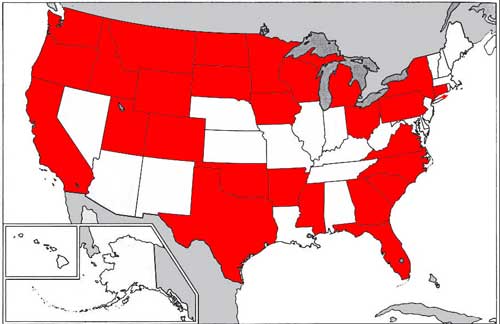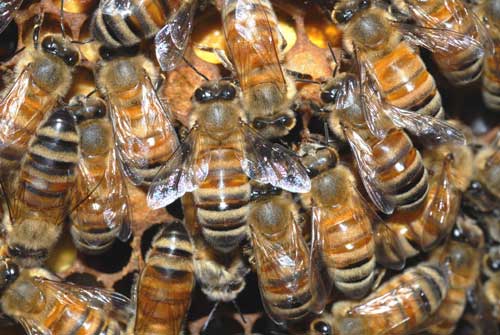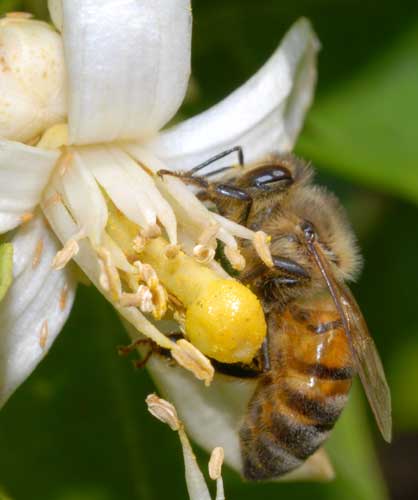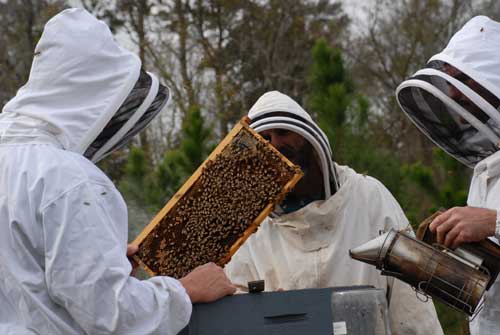
States (in red) where beekeepers are reporting significant honey bee losses to CCD.
Courtesy: Bee Alert Technologies, Inc.
Received from:
Dr. Jamie Ellis
Honey Bee Research and Extension Laboratory
Department of Entomology and Nematology
University of Florida
Bldg 970 Natural Area Drive
PO Box 110620
Gainesville, FL 32601
Email: jdellis@ufl.edu
Phone: 352 392 1901 ext. 130
The U.S. beekeeping industry has faced a number of obstacles to healthy bee management over the years. These obstacles range from arthropod pests to pathogenic diseases. Now a new problem threatens the beekeeping industry and it may eclipse altogether the bee maladies of old. Termed "colony collapse disorder" (or CCD), the disorder has gained considerable national and international attention.
Beekeepers around the United States have reported higher-than-usual colony losses since the fall of 2006. Some beekeepers in states reporting CCD have lost 50 to 90% of their colonies, often within a matter of weeks. This translates into thousands of dead colonies and millions of dead bees. In a country where honey bees contribute billions of dollars in added revenue to the agriculture industry, these bee losses cannot be taken lightly.

It has been difficult to assess the impact of CCD in the U.S. and globally. Nationally, beekeepers have been asked to complete a survey tool designed by Bee Alert Technologies, Inc. (the online version can be found at: http://www.beealert.info/). The survey tool is designed to assess the distribution and severity of CCD and to provide a means of determining what variables might be contributing to the problem. Thus far, most CCD impact data are based on anecdotal reports and early surveys provided by beekeepers. It is believed, however, that many thousands of bee colonies in the U.S. have died expressing symptoms of CCD since the fall of 2006.
CCD may not be a new disorder. In fact, many colonies have died over the past 50 to 60 years displaying symptoms similar to those of CCD. The disorder as described in older literature has been called spring dwindle disease, fall dwindle disease, autumn collapse, May disease, and disappearing disease. We may never know if these historic occurrences share a common cause with modern-day CCD. They do, however, share the symptoms.
Symptomatically, colonies with CCD can appear healthy as few as three weeks prior to collapse. However, the adult bees soon "disappear" (hence its historic nickname "disappearing disease") from the colonies, leaving behind a box full of honey, pollen, capped brood, a queen, and maybe a few worker bees. Beekeepers report that colonies with CCD do not contain any dead bees, neither are there dead bees on the ground outside of the colonies. The adult bees simply vanish. The final symptom is that small hive beetles, wax moths, and other nearby honey bees ignore the empty hives even though the hives contain foodstuffs on which they ordinarily feed.

The Mid-Atlantic Apiculture Research and Extension Consortium (MAAREC: http://www.ento.psu.edu/MAAREC/index.html) is the current clearing house for CCD-based information produced by the CCD Working Group. Composed of scientists, beekeepers, industry, and government officials, the CCD Working Group defined the symptoms of CCD as follows:
The cause of CCD is under investigation. At this point, almost every conceivable and realistic cause remains a possibility. The leading candidates and a brief explanation of their potential role are listed below. This list is not a comprehensive list and the candidates occur in no particular order. It is important to note that this list may change as new information on CCD becomes available. Such changes could result in the addition or exclusion of any of the following potential causes. The author makes no attempt to promote or undermine any one of the following theories.
Many scientists believe that CCD is caused by a combination of the factors above. To illustrate this point, some dead bees showing symptoms of CCD have had elevated levels of normally-benign pathogens in their bodies, possibly indicating a compromised immune system. In theory, any stress or combination of stresses (chemicals, genetic bottlenecks, varroa, etc.) can suppress a bee's immune system. Considering synergistic effects as a potential cause of CCD makes the disorder increasingly harder to study.
In general, most people respect honey bees, recognizing their importance, while being cautious when near them. This is not surprising because honey bees can inflict a painful sting. Stings aside, most people also recognize honey bees for the sweet honey that they produce. To be sure, the production and sale of honey supports thousands of beekeeper families and provides the consumer with an alternative to sugar (incidentally, there is no evidence that honey from CCD colonies is unsafe for human consumption). However, honey is of only minor importance compared to the benefits afforded humans by honey bee pollination.
Beekeepers managing their bees for purposes of pollination load their colonies on trucks and move them around the country, going from blooming crop to blooming crop. Growers pay beekeepers from $40 to 150 per colony just to ensure that they will have an adequate supply of honey bees to pollinate their crop. In return, the growers benefit by having a higher fruit/vegetable/nut production per acre, larger size and better shape of the product, and even enhanced product taste in many instances.
The benefits of honey bee pollination are not to be taken lightly. The simple act of beekeepers moving honey bees around the country ensures our country's food supply. Agriculture needs honey bees and their disappearance is cause for concern. Yet, no one believes that honey bees will disappear altogether, even with the concerns over CCD. Instead, the average American may experience increased food prices and decreased food availability if honey bees continue to die at the current rate. The almond industry illustrates this point well.

Almond producers in California continue to plant more acres of almonds every year yet honey bee populations have suffered a steady decline during the same time period. The latest estimation suggests that by 2010, California almonds will need every honey bee colony in North America just to be pollinated adequately. If all of the bees are going to California for almond pollination, what will happen to apples in Washington? Blueberries in Maine? Citrus in Florida? Etc.? This loss of bees could begin a price war in the pollination industry, resulting in growers being forced to pay higher rent prices for bee colonies. The net effect is that the consumer will have to pay a higher price for the food that they currently enjoy. In the worst case scenario, food availability will begin to decrease as honey bees die.
The benefits of honey bees are undeniable and often under-appreciated. Because CCD has initiated a rapid loss of colonies in the U.S. and globally, the general public should be alarmed. Perhaps the worst thing to come from all of this is that the loss of bees could signal a decline in the health of our environment. Honey bees are biological indicators, meaning that their status is a reflection of the health of the general environment. If true, bee losses may be the beginning of a much larger environmental issue.
In the past, most of the work on CCD has been conducted by those affiliated with the CCD Working Group. That is changing as more scientists are beginning to investigate various avenues of CCD. Beekeepers, governmental officials, and scientists from universities, industries, and the USDA have initiated a number of investigations into the possible causes of CCD. At this point, it is safe to assume that most potential causes of CCD are being investigated. In addition to this, many granting agencies realize the importance of honey bees and have begun to distribute research funds in an effort to find the cause and a cure.

(Modified from recommendations made by the CCD Working Group)
Because CCD is not well-understood, the CCD Working Group has made the following recommendations in an attempt to give beekeepers some control options.
There is a lack of refereed publications on CCD because: (1) it is new, and (2) it is not well-understood. Bee Alert Technology, Inc.'s and MAAREC's web sites (below) contain the most up-to-date information on CCD. Regardless, many news articles, videos, newsletters, etc. concerning CCD exist on the world wide web. A search for "colony collapse disorder" will yield more than 400,000 links.
Bee Alert Technology, Inc.: http://beealert.blackfoot.net/~beealert/index.php
Mid-Atlantic Apiary Research and Extension Consortium: http://www.ento.psu.edu/MAAREC/index.html